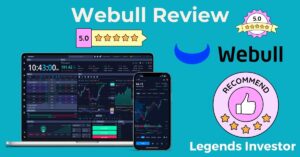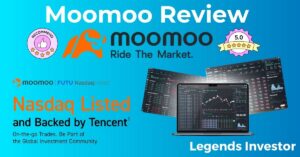
If you’re stepping into the world of online investing, you’ve likely come across the name Interactive Brokers. Known for its professional-grade tools and extensive market access, it’s touted as a go-to platform for serious traders. But with the vast ocean of brokers out to grab your attention, it comes down to equal parts research and instinct when picking the right one for you.
This isn’t just about finding a place to trade; it’s about ensuring your chosen broker aligns with your investment goals, trading style, and educational needs. I’m here to help you cut through the noise with an in-depth look at Interactive Brokers.
You’re going to find out about the user interface, cost structure, market access, and more. By the end of this article, you’ll have a clear picture of where Interactive Brokers stands in the online brokerage landscape, helping you make an informed decision.
Let’s move on and take a closer look at what it’s like to actually navigate and trade on Interactive Brokers. Fasten your seatbelt; we’re about to embark on the first leg of this trading platform odyssey.
Navigating the Interface: User Experience on Interactive Brokers
First up, when you land on Interactive Brokers, you’re going to notice a thing or two about user experience. Remember, a trading platform should be your ally, not a hurdle. So, let’s talk about what it’s like to actually use the platform, shall from setup to everyday trading.
Signing up is straightforward. You’re going to enter your details, answer a few regulatory questions, and usually, within a few business days, you’re set. Now, for novice traders, the interface can seem daunting at first, with its professional design and array of options. But don’t worry too much about it. Interactive Brokers offers a paper trading function to practice without risking real money. It’s a safe space to get acquainted with the ins and outs before diving into it with your hard-earned cash.
For the pros out there, this platform’s interface is something to be excited about. You can customize it to your heart’s content, which means you’re not stuck with a system that doesn’t cater to your specific trading style. And here’s a cool thing: Interactive Brokers’ Trader Workstation (TWS) is a powerhouse, with a menu of tools for charting, analysis, and order management that rival any other out there.
Of course, you’re not always going to be at your desk. That’s where the mobile app comes in. It’s not just a scaled-down version of their desktop platform. You get robust functionality that keeps you connected to global markets, 24/7, all from your smartphone. Order execution, monitoring positions, and accessing market data—it’s all in the palm of your hand.
Instrument Variety and Market Access
When you’re sizing up a brokerage, one of the first things you’re going to look at is what you can actually trade on their platform. I’ve taken a deep dive into the extensive lineup at Interactive Brokers, and it’s rather impressive. You’ve got everything from stocks and bonds to commodities and cryptocurrencies all waiting at your fingertips.
Part of the appeal is that you’re not restricted to the U.S. markets with Interactive Brokers. You can access over 150 markets across the globe, which opens up a massive sandbox for trading and investing. This is a boon for those wanting to diversify outside domestic equities and potentially capitalize on international trends.
You may think that having a vast selection is only advantageous for the seasoned pros, but it’s quite the contrary. If you’re just starting out, choosing a platform with a wide market reach means that as your knowledge grows, you won’t feel constrained by limited options. You’ll grow with the platform, taking on new markets as you gain confidence.
Now, let’s pivot to the educational aspect because stepping into the trading arena requires more than just a catalog of instruments; it requires knowledge. In the next section, I’m going to break down the learning resources Interactive Brokers puts at your disposal to ensure you’re not going in blind.
Educational Resources and Support for Traders
Interactive Brokers isn’t just about providing a platform for trading; it also emphasizes the education of its users. For traders who are keen to learn, the broker offers a robust selection of resources, from webinars to comprehensive courses.
I’ve taken a deep look at the educational offerings to see how they stack up. First off, their Traders’ Academy is a goldmine for those looking to expand their knowledge. It breaks down complex topics into digestible lessons, catering to both novices and seasoned investors.
The platform’s tutorials cover a wide spectrum, not shying away from intricate strategies and detailed market analyses. This commitment to education speaks volumes about the broker’s dedication to user empowerment and long-term value.
In addition to static content, Interactive Brokers further supports learning through live webinars, which allows direct interaction with experts. This is crucial for staying updated with the fast-moving financial markets and getting expert insights in real-time.
However, the sheer volume of resources can be overwhelming. You may wonder if the quality is consistent across the board. From what I’ve observed, the materials are not only extensive but also maintained with a high standard of clarity and detail.
I can’t overstate the importance of such a finely-tuned educational infrastructure. It equips users with the skills to make informed trading decisions, aligning perfectly with the broker’s suite of professional tools. As we pivot into evaluating costs and fees, remember that the right education can help you navigate these expenses more effectively, keeping your trading strategy cost-efficient.
Costs and Commissions: Analyzing the Fee Structure
I’m going to give you the straight scoop on Interactive Brokers’ fee structure. It’s important to understand the costs attached to any trading platform you’re using, and Interactive Brokers is no exception. This isn’t just about the commission costs; you’ve also got to consider non-trading fees, such as withdrawal and inactivity fees.
Interactive Brokers has a reputation for competitive pricing, especially for active traders. You’re going to find out about their tiered and fixed pricing options, which cater to different trading volumes and styles. Don’t worry too much about the complexity; I’ll break it down clearly so you can see how costs can affect your investments.
If you want to compare this platform with others out there, cost is a key factor. Interactive Brokers offers lower commission rates on stocks compared to many other platforms, making it a choice worth considering for high-volume traders. However, for casual investors, the minimum monthly activity fees could make it less attractive.
Choose something that resonates with your own trading habits. If you’re trading frequently, the tiered pricing model could be more cost-effective for you. On the other hand, if you’re more about buy-and-hold, the fixed-rate plan may suit you better.
You can always adjust your approach down the road, but it’s helpful to start on the right foot. And let’s not forget other possible fees like market data, research subscriptions, and the cost for using premium tools. We’ll touch on those briefly as well.
A lot is happening very quickly in the world of online brokerage fees, and no doubt, it’s a competitive space. That’s the strategy I like to leverage when thinking about costs: staying aware and making adjustments as needed.
This isn’t where the conversation about Interactive Brokers ends. Your fee analysis should lead into thinking about how well-prepared you are against the risks of trading. I really hope that you’re already pivoting towards the next section in your mind. It’s all about risk management tools and features, a crucial piece of the trading puzzle.
Risk Management Tools and Features
Interactive Brokers understands that trading comes with its risks, and managing those risks effectively is crucial to any trader’s success. That’s precisely why they offer a suite of robust risk management tools designed to help protect your investments.
I’m going to highlight some key risk management features you’ll find with Interactive Brokers. Their Risk Navigator tool, for example, offers a real-time market risk management platform that can help you adjust your investment strategy dynamically as market conditions change. You can model ‘what-if’ scenarios, get a comprehensive risk assessment across multiple asset classes, and immediately see the potential impact of hypothetical market movements on your portfolio.
Another vital component is the PortfolioAnalyst, which isn’t just about tracking your gains and losses; it’s also about providing you with detailed reports and insights about the risk distribution across your investments. With this feature, you’re going to find out about risk concentrations and excesses that could otherwise be overlooked.
For traders who need to protect an open position, Interactive Brokers also delivers on the fronts of stop loss orders and option hedging strategies. A stop loss order ensures that your positions are automatically sold when a certain price is reached, minimizing potential losses. Meanwhile, option hedging strategies can be used to offset potential losses in the positions of other securities.
Don’t worry too much about feeling overwhelmed by these tools. Interactive Brokers caters to all levels of experience by providing educational resources that help you understand and effectively use each risk management feature. It’s not all about having the tools; it’s also about knowing when and how to use them.
Customer Service: Responsiveness and Quality
I’m going to delve into the nitty-gritty of Interactive Brokers’ customer service. Now, why is this important? Think about it: trading can be complex, and you’ll want someone to have your back when you hit a snag. I’ve sifted through various user feedback to give you the real scoop on what to expect when reaching out for help.
Interactive Brokers offers customer support through multiple channels including email, phone, and live chat. But I know what counts is how effective these channels truly are. Let’s look at the responsiveness first. Typically, emails get answered within a day, but during market volatility or peak times, be prepared for potential delays. Phone support, on the other hand, is more immediate, and Interactive Brokers’ live chat feature is often praised for quick resolutions.
Digging into the quality of support, the expertise of customer service representatives is crucial. From my observation, their reps seem to have a solid grip on trading concepts and platform-specific queries. However, your experiences might vary, and some traders have noted that intricate issues could take longer to resolve. This is common in the industry, but it doesn’t make it any less frustrating.
What really paints the full picture are the experiences of the trading community. Scanning through forums and review sites, the feedback is quite mixed. It seems that while many users have had positive interactions, others have faced difficulties with more complex concerns.
As we’re preparing to trust Interactive Brofers with our investments, the importance of issues being handled efficiently can’t be understated. Now, let’s shift gears and look into why you can sleep a little easier at night knowing that Interactive Brokers takes your security seriously in the next section.
Security and Regulation: Trusting Your Broker
Now, let’s talk about something that’s absolutely vital when you’re putting your money on the line: security and regulation. Interactive Brokers doesn’t play around in this arena – they’ve taken some robust measures to ensure that your investments and personal information are well-protected. This isn’t just about a secure login; we’re diving into comprehensive safety features like two-factor authentication, sophisticated encryption, and regular financial audits.
When you’re entrusting a company with your finances, you want to be sure they’re on the level. That’s where regulation comes in. Interactive Brokers is regulated by several top-tier financial authorities around the world, including the SEC and CFTC in the United States, the FCA in the UK, and the ASIC in Australia. This level of oversight signals that they’re committed to adhering to strict industry standards and providing a transparent trading experience.
But security and regulation don’t just give you peace of mind; they’re also a significant factor in the longevity and reliability of a broker. How so? Well, with stringent regulatory requirements, brokers like Interactive Brokers must maintain certain capital reserves and submit to periodic reviews. This can really make you feel more confident that the platform will be around for the long haul and can weather financial storms.
Remember, strong security protocols and a green light from financial watchdogs set the stage for trust. And let’s be honest, in the world of online trading, trust is a key currency. So, if you’re weighing up whether Interactive Brokers is the right fit for you, their commitment to security and adherence to regulation should be a big tick in the pro column.
Comparative Analysis: How Interactive Brokers Stands Against Peers
You’ve reached the final stretch, and by now, you’re armed with a trove of details on Interactive Brokers. But how does it really stack up against its rivals in the crowded online brokerage arena?
To provide a balanced view, I’ve pitted Interactive Brokers against top competitors, scrutinizing everything from user interface to fee structures, market access, and customer support.
When it comes to market reach and the variety of instruments, Interactive Brokers often leads the pack. They’ve made a name for themselves with their extensive selection, especially appealing for those looking to trade internationally.
Their fees are competitive, not always the lowest, but you’re getting value in terms of the tools and resources available. However, if you value simplicity and lower costs above all else, you might find other platforms more aligned with your needs.
In the support and education departments, Interactive Brokers has made significant strides. Although initially seen as a platform for the pros, they’ve expanded their resources with initiatives targeting beginners.
As for security, you can breathe easy. Interactive Brokers takes this seriously, and it’s wrapped up in a robust regulatory framework, assuring your investment is well protected.
So here’s the bottom line: Interactive Brokers is a formidable contender that may very well serve as your gateway to the global markets. It’s best suited for the seasoned investor or the beginner with a thirst for learning and a taste for diversity in their portfolio.
Remember, this is a snapshot meant to guide, not dictate your choice. Your decision should be as unique as your trading style. Choose something that resonates with you, and if that’s Interactive Brokers, you’re in good company.
I’d love to hear your feedback on this review or your personal experiences with Interactive Brokers. Sharing insights enriches us all – drop your thoughts in the comments, and let’s keep this conversation going.



